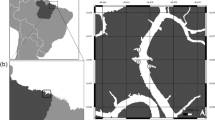Abstract
Young plaice (Pleuronectes platessa L.), caught in the intertidal zone, exhibit a short-lived tidal rhythm when their activity is recorded in darkness in the laboratory. This tidal rhythm rapidly changes to one of circadian frequency both in darkness and in light-dark cycles. It is considered that the basic rhythm is circadian in nature, but that it can be entrained to keep in phase with the tides by some, as yet unknown, Zeitgeber present under tidal conditions.
Similar content being viewed by others
Literature Cited
Andreasson, S.: Locomotory activity patterns of Cottus poecilopus Heckel and C. gobio L. (Pisces). Oikos 20, 78–94 (1969).
Aschoff, J.: Circadian activity patterns with two peaks. Ecology 47, 657–662 (1966).
Bohun, S. and H. E. Winn: Locomotor activity of the American eel (Anguilla rostrata). Chesapeake Sci. 7, 137–147 (1966).
Bregneballe, F.: Plaice and flounder as consumers of the microscopic bottom fauna. Meddr Danm. Fisk.-og Havunders. 3, 133–182 (1961).
de Groot, S. J.: Diurnal activity and feeding habits of plaice. Rapp. P.-v. Réun. Cons. perm. int. Explor. Mer 155, 48–51 (1964).
— On the interrelationships between morphology of the alimentary tract, food and feeding behaviour in flatfishes (Pisces: Pleuronectiformes). Neth. J. Sea Res. 5, 121–196 (1971).
Edwards, R. and J. H. Steele: The ecology of 0-group plaice and common dabs at Lochewe. I. Population and food. J. exp. mar. Biol. Ecol. 2, 215–238 (1968).
Gibson, R. N.: Experiments on the tidal rhythm of Blennius pholis. J. mar. biol. Ass. U.K. 47, 97–111 (1967).
—: Activity rhythms in two species of Blennius from the Mediterranean. Vie Milieu (Sér. A) 20, 235–244 (1969).
— Factors affecting the rhythmic activity of Blennius pholis L. (Teleostei). Anim. Behav. 19, 336–343 (1971).
— The intertidal movements and distribution of young fish on a sandy beach with special reference to the plaice (Pleuronectes platessa L.). J. exp. mar. Biol. Ecol. 12, 79–102 (1973).
Gompel, M.: Recherches sur la consommation d'oxygéne de quelques animaux aquatiques littoraux. C.r. hebd. Séanc. Acad. Sci., Paris 205, 816–818 (1937).
Harder, W. und G. Hempel: Studien zur Tagesperiodik der Activität von Fischen. I. Versuche an Plattfischen. Kurze Mitt. Inst. FischBiol. Univ. Hamb. 5, 22–31 (1954).
Hasler, A. D. and J. Bardach: Observations of daily migrations of perch in Lake Mendota. Wis. J. Wildl. Manage. 13, 40–51 (1949).
Honegger, H.-W.: Rhythmic motor activity responses of the California fiddler crab Uca crenulata to artificial light conditions. Mar. Biol. 18, 19–31 (1973).
Kruuk, H.: Diurnal periodicity in the activity of the common sole, Solea vulgaris Quensel. Neth. J. Sea Res. 2, 1–28 (1963).
Livingston, R. J.: A volumetric respirometer for long-term studies of small aquatic animals. J. mar. biol. Ass. U.K. 48, 485–497 (1968).
Naylor, E.: Locomotory rhythms in Carcinus maenas (L.) from non-tidal conditions. J. exp. Biol. 37, 481–488 (1960).
O'Connor, J. M.: Tidal activity rhythm in the hogchoker Trinectes maculatus (Bloch and Schneider). J. exp. mar. Biol. Ecol. 9, 173–177 (1972).
Olla, B. L., C. E. Samet and A. L. Studholme: Activity and feeding behaviour of the summer flounder (Paralichthys dentatus) under controlled laboratory conditions. Fish. Bull. U.S. 70, 1127–1136 (1972).
Protasov, V. R.: Some features of the vision of fishes. Inst. Morfologii Zhivotnykh, Akad. Nauk. SSSR. 29-48 (1964). [Transl.: Marine Laboratory, Aberdeen, 949].
Rodriguez, E. and E. Naylor: Behavioural rhythms in littoral prawns. J. mar. biol. Ass. U.K. 52, 81–95 (1972).
Stickney, A. P.: The locomotor activity of juvenile herring (Clupea harengus harengus L.) in response to changes in illumination. Ecology 53, 438–445 (1972).
Swift, D. R.: Activity cycles in brown trout (Salmo trutta L.). 1. Fish feeding naturally. Hydrobiologia 20, 241–247 (1962).
Verheijen, F. J. and S. J. de Groot: Diurnal activity of plaice and flounder in aquaria. Neth. J. Sea Res. 3, 383–390 (1967).
Wikgren, B.-J.: Daily activity pattern of the burbot. Memo. Soc. Fauna Flora fenn. 31, 91–97 (1956).
Author information
Authors and Affiliations
Additional information
Communicated by J. H. S. Blaxter, Oban
Rights and permissions
About this article
Cite this article
Gibson, R.N. Tidal and circadian activity rhythms in juvenile plaice, Pleuronectes platessa . Mar. Biol. 22, 379–386 (1973). https://doi.org/10.1007/BF00391398
Accepted:
Published:
Issue Date:
DOI: https://doi.org/10.1007/BF00391398




